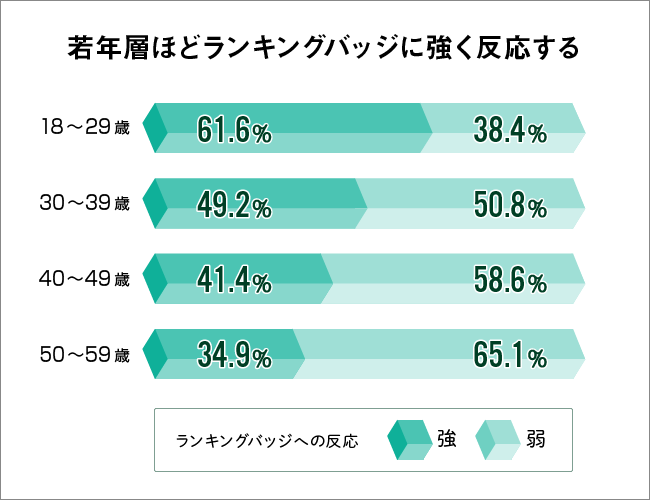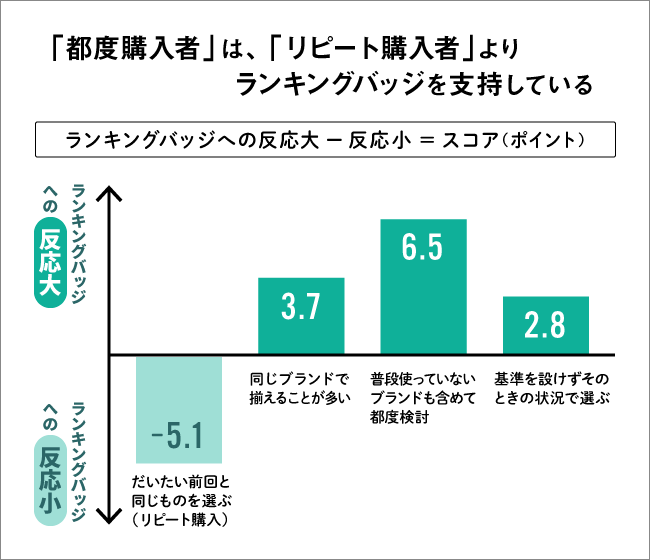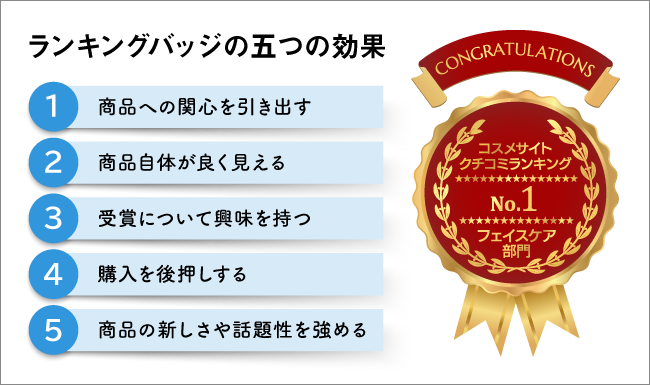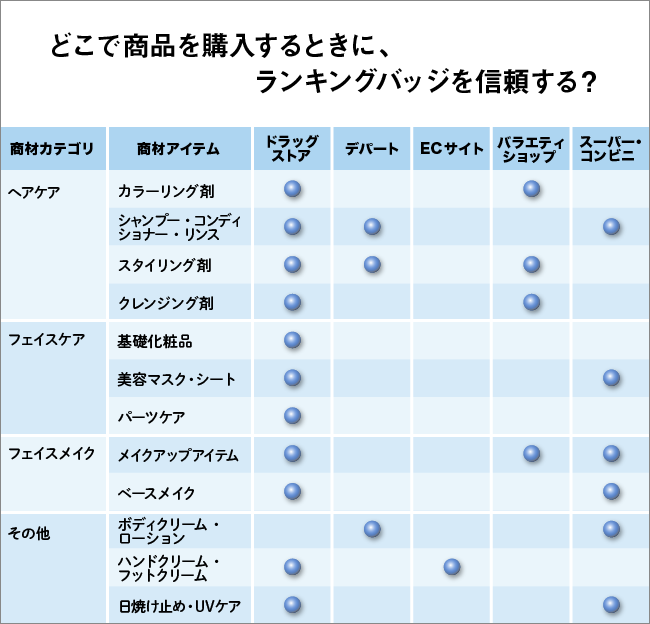Note: This website was automatically translated, so some terms or nuances may not be completely accurate.
In what cases and for whom do ranking badges prove effective?
Ranking badges fall into two main categories: those displaying rankings like "#1 in sales on XX site!" and those displaying awards selected independently by media outlets, such as "XX Grand Prix."
Dentsu Digital Inc. and Dentsu Inc. jointly conducted a consumer survey to verify the effectiveness of ranking badges bearing the names of 13 beauty media outlets on 12 beauty care products across 4 categories (*). This valuable database also captured beauty awareness data.
Building on these findings, we begin examining ranking badges from the fundamental perspective: "Do they actually influence purchases?" We then report on the "Theory of Ranking Badge Effectiveness" from multiple angles—by generation, purchasing method, media outlet, type of effect, purchase location, and beauty sensitivity—and touch on its potential as a planning method.
*4 Categories: Hair Care, Face Care, Face Makeup, Other (Body Care, etc.). 12 Items: Hair Colorants, Shampoo/Conditioner/Rinse, Styling Products, Cleansers/Facial Washes, Skincare Basics, Beauty Masks/Sheets, Part Care, Makeup Items, Base Makeup, Body Cream/Body Lotion, Hand Cream/Foot Cream, Sunscreen/UV Care.
Approximately 50% of people cite ranking badges as a trigger or deciding factor for product purchases.
"Do ranking badges seen in stores truly contribute to purchases?"
Given the lack of previous research on this topic, this was the key point we most wanted to clarify in this survey.
In conclusion, across all product categories, about 50% of respondents stated ranking badges "prompted them to purchase a product." Furthermore, 40-50% said they "decided to purchase a product" because of them.
Given the ever-increasing volume of information consumers encounter daily and the proliferation of channels, a 50% rate is remarkably high.
Even more interesting are the characteristics by generation, purchasing method, and media.
●Generational Trends
Ranking badges showed particularly strong support among the 18-29 age group, who are active consumers of beauty care products. It was surprising that this younger demographic, known for actively gathering information online, responded so strongly to in-store ranking badges.

Ranking badge evaluation by age group. Survey participants: 323 aged 18-29, 522 aged 30-39, 683 aged 40-49, 599 aged 50-59.
● Trends by purchasing method
Particularly in the face makeup and face care categories, "one-time buyers" showed a stronger tendency to support ranking badges than "repeat buyers." This suggests that ranking badges function as a trigger for consumers who regularly switch products to try new items.

Differences in cosmetics purchasing behavior between ranking badge positive group (TOP3) and negative group (BOTTOM4) (Face Makeup Category). Score = ranking badge positive group value (%) - negative group value.
● Trends by Media Type
The survey on ranking badge awareness and trust rates by media type showed clear differences across the 13 media outlets surveyed. In terms of awareness, "EC Site B" and "Beauty Review Site A" exceeded 65%. "Beauty Review Site A" demonstrated high trust rates alongside its awareness, clearly showing the power of this media outlet.
Looking beyond mere awareness scores to the gap with trust rates, "Beauty Magazines" showed the smallest overall difference. Beauty media originating from magazines generally followed this trend, suggesting this result proves the authority of beauty magazines that cannot be explained by reach alone.

Ranking badges have five effects!
Based on the survey results, we were able to categorize the effects of ranking badges into the following five:

Let's examine the characteristics of these five categorized effects by product and media type.
・For all surveyed products, "beauty review sites" ranked highest in generating interest. This is likely because the media itself is widely recognized and holds high trust as a beauty information source, serving as a trigger to capture many people's interest.
・"International fashion magazines" make products appear more appealing through ranking badges. The sophisticated image associated with globally authoritative overseas media likely influences the perception of the products themselves.
・Interest in the specific award content of ranking badges (e.g., "○○ Grand Prix") is again highest on "beauty review sites." Additionally, "EC sites" tend to contribute more for "hand/foot care products" and "UV care products," while "beauty magazines" also play a role for some "face care products" and "hair care products." The reason is likely that EC sites focus on popularity and actual sales near the point of purchase, while beauty magazines draw interest from the perspective of what the editorial team's endorsement signifies.
・Ranking badges on "beauty review sites" are a key purchase driver. Displaying these badges alongside user ratings is thought to spark interest in the products.
・The effect of enhancing a product's novelty or buzz tends to vary by media type. For hair care, face care, and face makeup products, "online information portals" and "domestic fashion magazines" generally perform well. While these portals and magazines lack the specialization of dedicated beauty media, they may be valued precisely because they offer new discoveries to audiences with relatively lower beauty awareness.
While "beauty review sites" were found to be influential overall, as mentioned earlier, breaking down the types of effects reveals that each media channel has distinct strengths.
Does the effect of ranking badges vary based on consumers' beauty sensitivity or where they make purchases?
Next, let's examine trends by "beauty sensitivity" and "purchase location."
● Trends by Beauty Sensitivity
For the "high beauty sensitivity segment," ranking badges show strong effectiveness for the following products:
・Styling products
・Cleansing products
・Basic skincare products
・Beauty masks/sheets
・Makeup items
・Body Creams & Lotions
・Sunscreen & UV protection
On the other hand,
・Hair coloring products
・Shampoo・Conditioner・Rinse
・Parts care
・Base makeup
・Hand cream, foot cream, etc. showed no significant characteristics.
For makeup items and styling products, it's likely that those with higher beauty sensitivity tend to have stronger preferences. People with strong preferences may own multiple different items within the same category and use them selectively, so the effect of ranking badges is expected to be particularly noticeable.
● Trends by Purchase Location
For most products outside "Body Care," ranking badges were trusted at drugstores. Variety stores, supermarkets, and convenience stores also earned trust for many products, particularly in the lower price range.
Conversely, department store shoppers mostly trust "beauty consultants' advice." However, ranking badges seem to be valued when purchasing items like shampoo, styling products, hand care, and foot care products.

Ranking badges become more effective when paired with third-party opinions or expert information.
Analyzing these survey results also reveals what other information sources people who strongly react to ranking badges trust and reference. For example, in facial care and makeup, a pattern emerges where they gather information through "web-related sources including word-of-mouth + in-store information + ranking badges."
Specifically, they refer to sources such as:
・Face Care… "Beauty cosmetics review sites," "in-store POP displays," "SNS accounts," "review posting sites/e-commerce sites"
・Face Makeup… "Beauty Review Sites," "In-Store POP," "Influential YouTubers," "Online Information," "Online Review Information," "Store-Based Information"
As mentioned in the beauty awareness section, it's likely that ranking badge information will be most effective when it reaches people seeking third-party information like reviews or more detailed information.
Finally, the vast survey data obtained this time enables us to examine communication from various angles. For example, it may be possible to verify patterns such as: "What are the information acquisition characteristics, along the timeline leading to purchase, for individuals who recognize and trust ranking badges from Media XX, have high beauty sensitivity, and regularly purchase XX products?"
In today's environment where both communication and sales channels are becoming increasingly complex and multi-faceted, we hope that the meaningful insights gained specifically regarding ranking badges will contribute to the gradual evolution of future communication strategies for beauty care products.
For inquiries regarding survey results: Dentsu Digital Inc.ap4@dentsudigital.co.jp
<Survey Overview>
・Survey Method: Internet survey (screening survey + main survey)
・Survey Area: Nationwide
・Target Participants: Women aged 18–59 who use beauty care products (identified through screening survey as purchasers within the past 6 months)
*Excluded: Employees of advertising agencies, market research/consulting firms, and cosmetics manufacturers.
・Valid Responses: Screening Survey: 19,968 responses, Main Survey: 2,127 valid responses
・Survey Period: Screening Survey: December 14-17, 2018; Main Survey: December 21-25, 2018
・Presentation items: 13 ranking badge images
Was this article helpful?
Newsletter registration is here
We select and publish important news every day
For inquiries about this article
Author

Kohei Noda
Dentsu Digital Inc.
Advertising Business Account Planning Department
Planning Division 4 Manager
Born in 1986. Has consistently worked in the digital advertising field, handling media operations and planning. Transferred to Dentsu Digital Inc. in April 2018, where he has been engaged in planning for cosmetics and daily goods manufacturers to the present.

